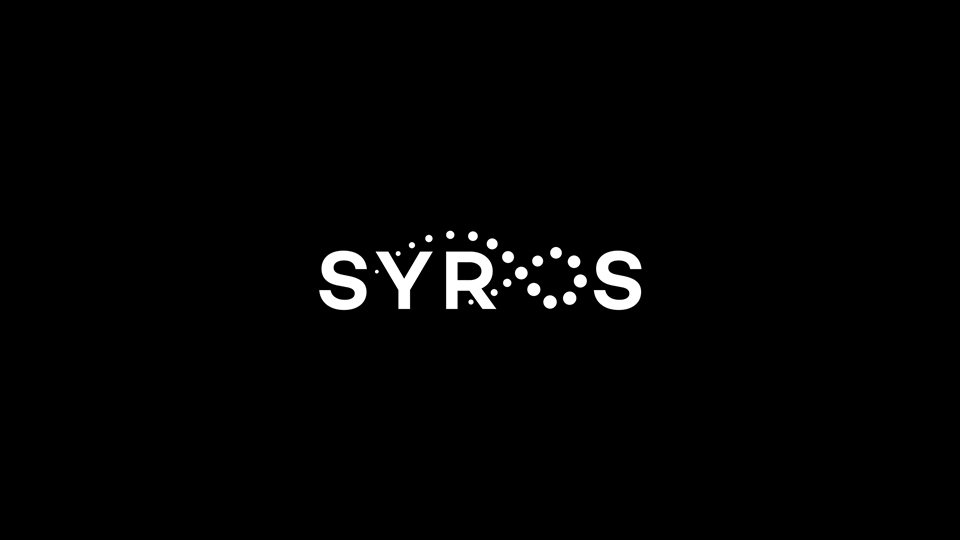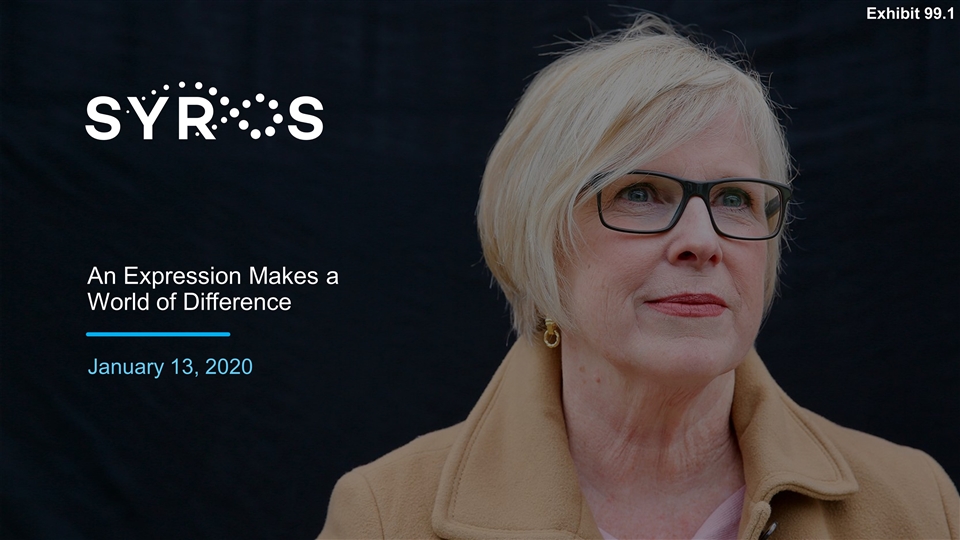
An Expression Makes a World of Difference January 13, 2020 Exhibit 99.1
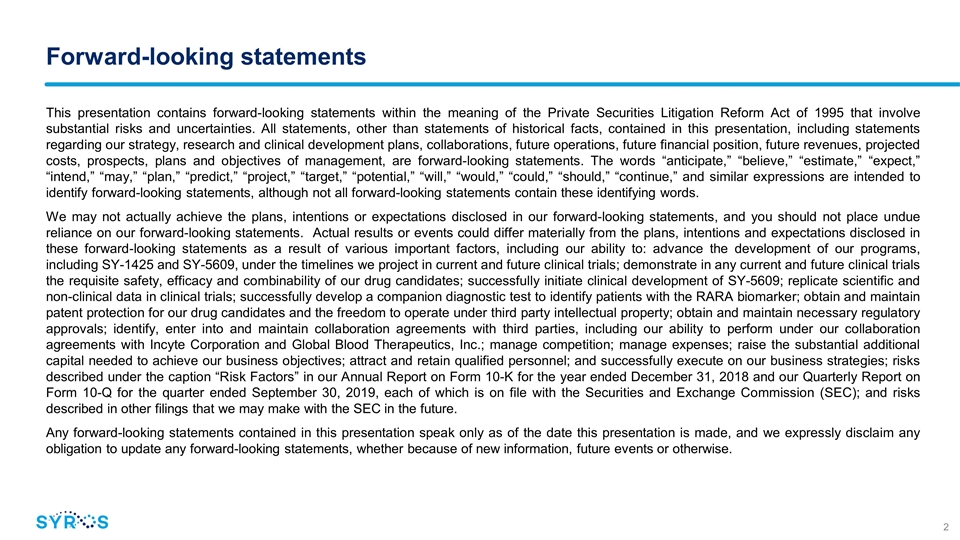
Forward-looking statements This presentation contains forward-looking statements within the meaning of the Private Securities Litigation Reform Act of 1995 that involve substantial risks and uncertainties. All statements, other than statements of historical facts, contained in this presentation, including statements regarding our strategy, research and clinical development plans, collaborations, future operations, future financial position, future revenues, projected costs, prospects, plans and objectives of management, are forward-looking statements. The words “anticipate,” “believe,” “estimate,” “expect,” “intend,” “may,” “plan,” “predict,” “project,” “target,” “potential,” “will,” “would,” “could,” “should,” “continue,” and similar expressions are intended to identify forward-looking statements, although not all forward-looking statements contain these identifying words. We may not actually achieve the plans, intentions or expectations disclosed in our forward-looking statements, and you should not place undue reliance on our forward-looking statements. Actual results or events could differ materially from the plans, intentions and expectations disclosed in these forward-looking statements as a result of various important factors, including our ability to: advance the development of our programs, including SY-1425 and SY-5609, under the timelines we project in current and future clinical trials; demonstrate in any current and future clinical trials the requisite safety, efficacy and combinability of our drug candidates; successfully initiate clinical development of SY-5609; replicate scientific and non-clinical data in clinical trials; successfully develop a companion diagnostic test to identify patients with the RARA biomarker; obtain and maintain patent protection for our drug candidates and the freedom to operate under third party intellectual property; obtain and maintain necessary regulatory approvals; identify, enter into and maintain collaboration agreements with third parties, including our ability to perform under our collaboration agreements with Incyte Corporation and Global Blood Therapeutics, Inc.; manage competition; manage expenses; raise the substantial additional capital needed to achieve our business objectives; attract and retain qualified personnel; and successfully execute on our business strategies; risks described under the caption “Risk Factors” in our Annual Report on Form 10-K for the year ended December 31, 2018 and our Quarterly Report on Form 10-Q for the quarter ended September 30, 2019, each of which is on file with the Securities and Exchange Commission (SEC); and risks described in other filings that we may make with the SEC in the future. Any forward-looking statements contained in this presentation speak only as of the date this presentation is made, and we expressly disclaim any obligation to update any forward-looking statements, whether because of new information, future events or otherwise.
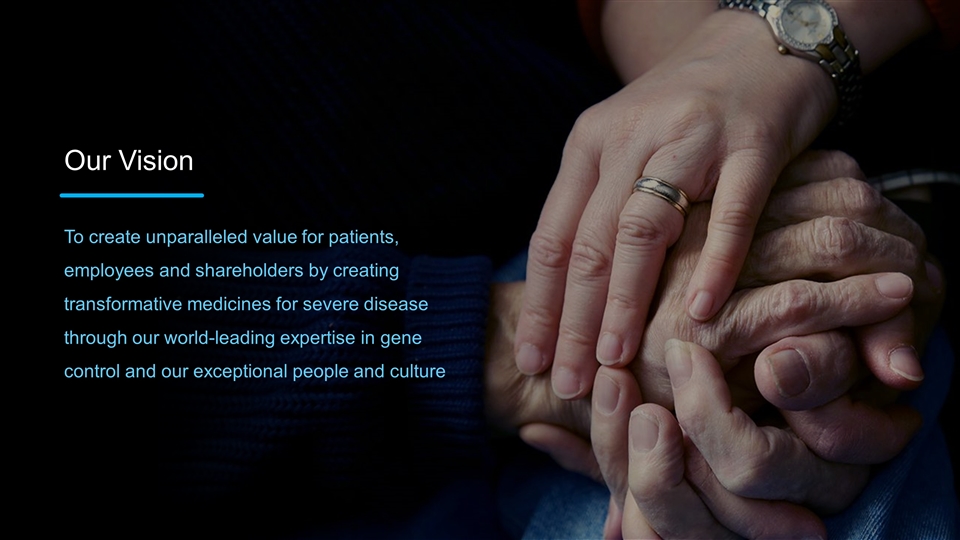
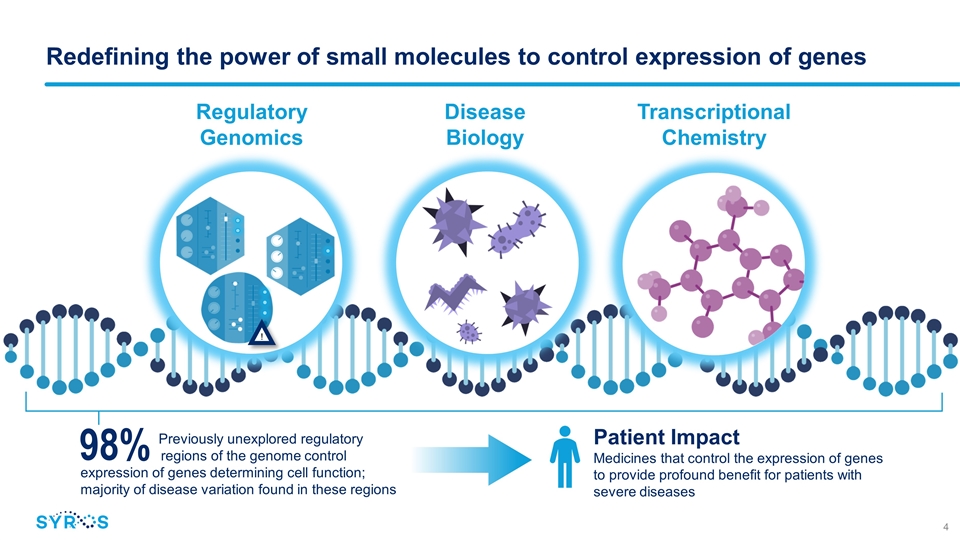
Previously unexplored regulatory regions of the genome control expression of genes determining cell function; majority of disease variation found in these regions 98% Patient Impact Medicines that control the expression of genes to provide profound benefit for patients with severe diseases Redefining the power of small molecules to control expression of genes ! Regulatory Genomics Disease Biology Transcriptional Chemistry
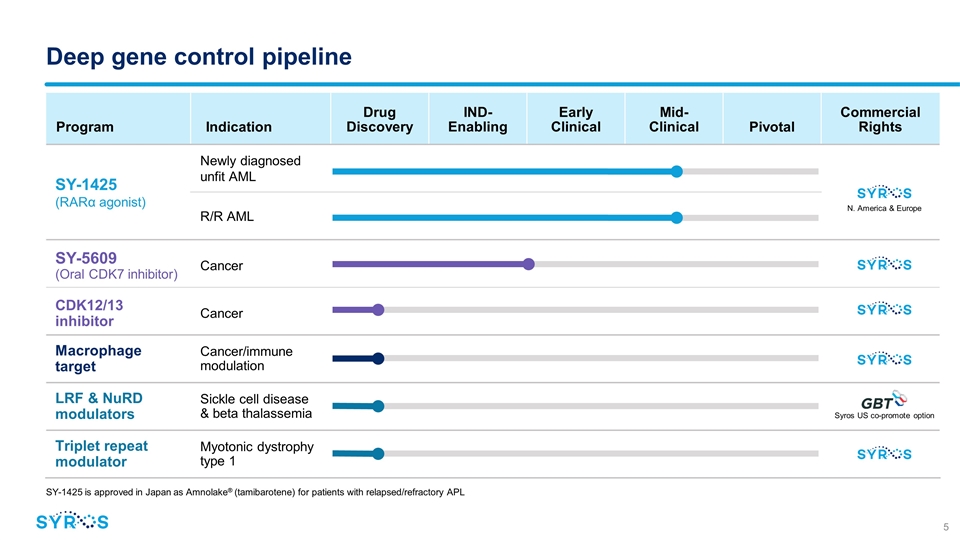
Program Indication Drug Discovery IND- Enabling Early Clinical Mid- Clinical Pivotal Commercial Rights SY-1425 (RARα agonist) Newly diagnosed unfit AML R/R AML SY-5609 (Oral CDK7 inhibitor) Cancer CDK12/13 inhibitor Cancer Macrophage target Cancer/immune modulation LRF & NuRD modulators Sickle cell disease & beta thalassemia Triplet repeat modulator Myotonic dystrophy type 1 Deep gene control pipeline SY-1425 is approved in Japan as Amnolake® (tamibarotene) for patients with relapsed/refractory APL N. America & Europe Syros US co-promote option
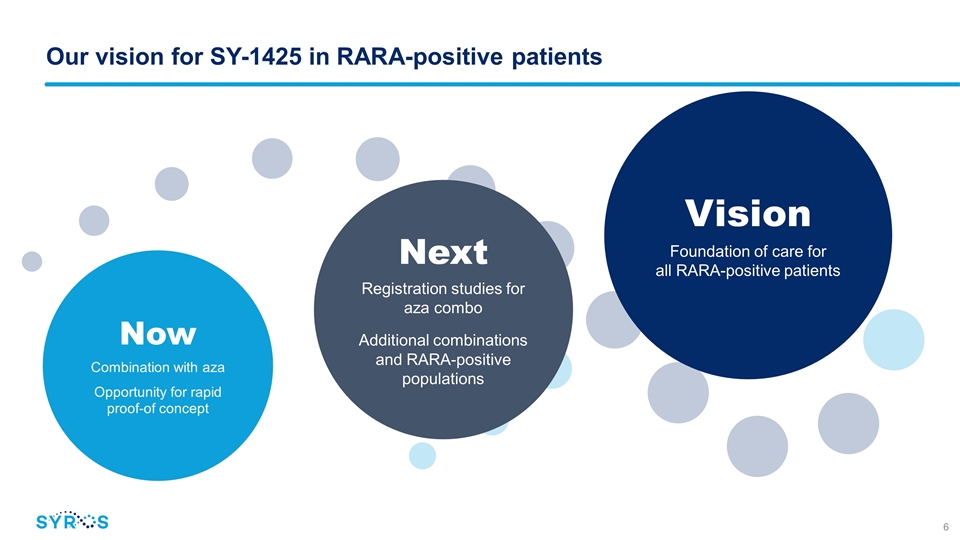
Our vision for SY-1425 in RARA-positive patients Now Combination with aza Opportunity for rapid proof-of concept Next Registration studies for aza combo Additional combinations and RARA-positive populations Vision Foundation of care for all RARA-positive patients
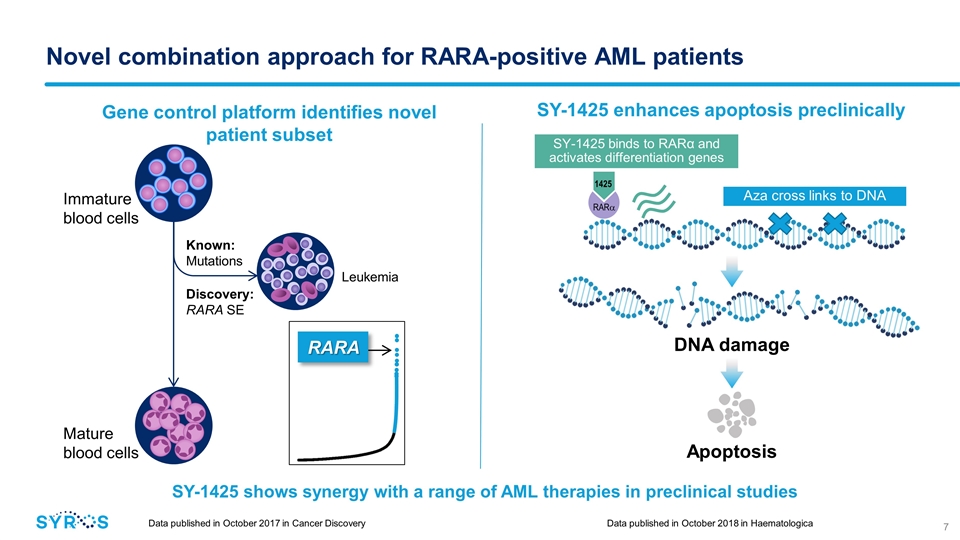
1425 SY-1425 binds to RARα and activates differentiation genes Novel combination approach for RARA-positive AML patients RARa Aza cross links to DNA SY-1425 enhances apoptosis preclinically Apoptosis DNA damage Gene control platform identifies novel patient subset SY-1425 shows synergy with a range of AML therapies in preclinical studies Data published in October 2018 in Haematologica Data published in October 2017 in Cancer Discovery Immature blood cells Mature blood cells Discovery: RARA SE Known: Mutations RARA Leukemia
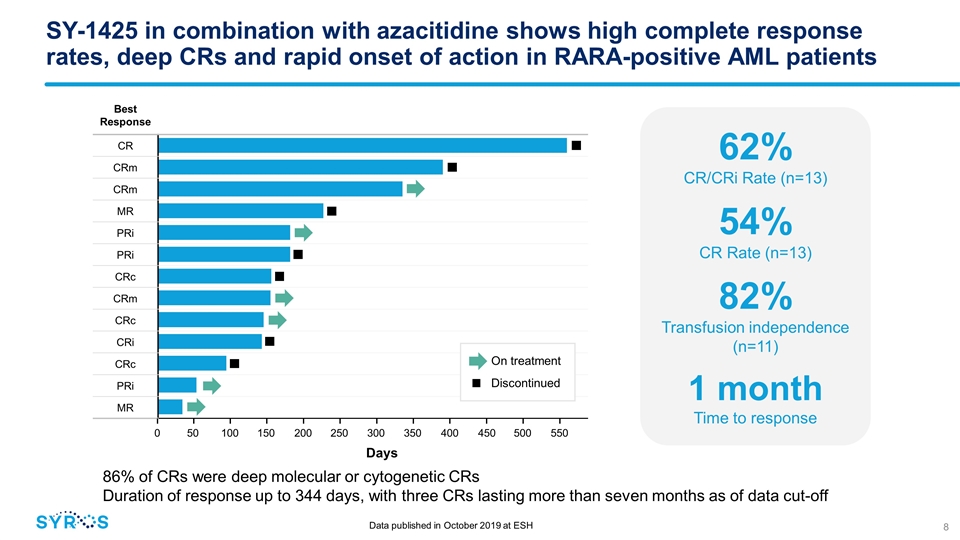
Best Response CR CRm CRm MR PRi PRi CRc CRm CRc CRi CRc PRi MR SY-1425 in combination with azacitidine shows high complete response rates, deep CRs and rapid onset of action in RARA-positive AML patients 0 50 100 150 200 250 300 350 400 450 500 550 86% of CRs were deep molecular or cytogenetic CRs Duration of response up to 344 days, with three CRs lasting more than seven months as of data cut-off Days On treatment Discontinued 62% CR/CRi Rate (n=13) 54% CR Rate (n=13) 82% Transfusion independence (n=11) 1 month Time to response Data published in October 2019 at ESH
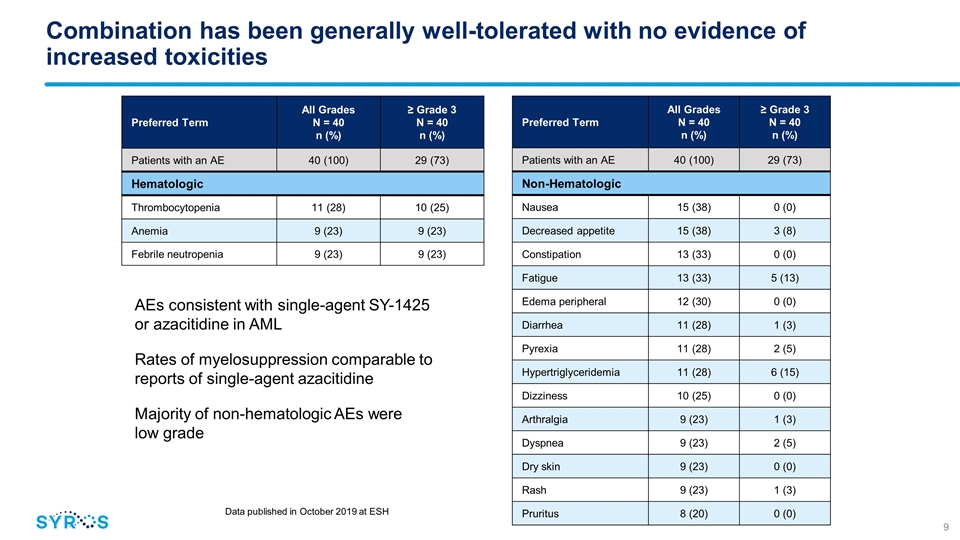
Combination has been generally well-tolerated with no evidence of increased toxicities AEs consistent with single-agent SY-1425 or azacitidine in AML Rates of myelosuppression comparable to reports of single-agent azacitidine Majority of non-hematologic AEs were low grade Preferred Term All Grades N = 40 n (%) ≥ Grade 3 N = 40 n (%) Patients with an AE 40 (100) 29 (73) Non-Hematologic Nausea 15 (38) 0 (0) Decreased appetite 15 (38) 3 (8) Constipation 13 (33) 0 (0) Fatigue 13 (33) 5 (13) Edema peripheral 12 (30) 0 (0) Diarrhea 11 (28) 1 (3) Pyrexia 11 (28) 2 (5) Hypertriglyceridemia 11 (28) 6 (15) Dizziness 10 (25) 0 (0) Arthralgia 9 (23) 1 (3) Dyspnea 9 (23) 2 (5) Dry skin 9 (23) 0 (0) Rash 9 (23) 1 (3) Pruritus 8 (20) 0 (0) Preferred Term All Grades N = 40 n (%) ≥ Grade 3 N = 40 n (%) Patients with an AE 40 (100) 29 (73) Hematologic Thrombocytopenia 11 (28) 10 (25) Anemia 9 (23) 9 (23) Febrile neutropenia 9 (23) 9 (23) Data published in October 2019 at ESH
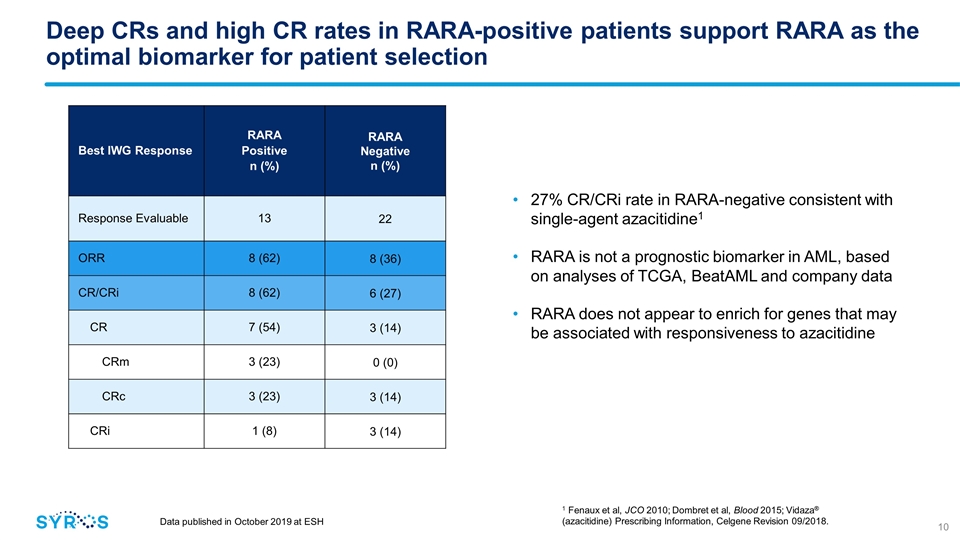
Deep CRs and high CR rates in RARA-positive patients support RARA as the optimal biomarker for patient selection 27% CR/CRi rate in RARA-negative consistent with single-agent azacitidine1 RARA is not a prognostic biomarker in AML, based on analyses of TCGA, BeatAML and company data RARA does not appear to enrich for genes that may be associated with responsiveness to azacitidine Best IWG Response RARA Positive n (%) RARA Negative n (%) Response Evaluable 13 22 ORR 8 (62) 8 (36) CR/CRi 8 (62) 6 (27) CR 7 (54) 3 (14) CRm 3 (23) 0 (0) CRc 3 (23) 3 (14) CRi 1 (8) 3 (14) Data published in October 2019 at ESH 1 Fenaux et al, JCO 2010; Dombret et al, Blood 2015; Vidaza® (azacitidine) Prescribing Information, Celgene Revision 09/2018.
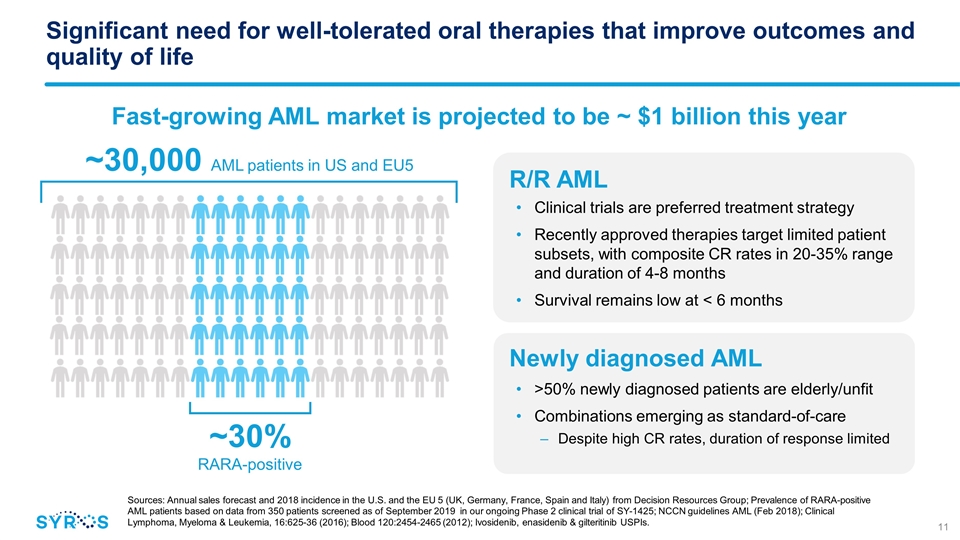
Significant need for well-tolerated oral therapies that improve outcomes and quality of life Fast-growing AML market is projected to be ~ $1 billion this year R/R AML Clinical trials are preferred treatment strategy Recently approved therapies target limited patient subsets, with composite CR rates in 20-35% range and duration of 4-8 months Survival remains low at < 6 months Newly diagnosed AML >50% newly diagnosed patients are elderly/unfit Combinations emerging as standard-of-care Despite high CR rates, duration of response limited Sources: Annual sales forecast and 2018 incidence in the U.S. and the EU 5 (UK, Germany, France, Spain and Italy) from Decision Resources Group; Prevalence of RARA-positive AML patients based on data from 350 patients screened as of September 2019 in our ongoing Phase 2 clinical trial of SY-1425; NCCN guidelines AML (Feb 2018); Clinical Lymphoma, Myeloma & Leukemia, 16:625-36 (2016); Blood 120:2454-2465 (2012); Ivosidenib, enasidenib & gilteritinib USPIs. ~30% RARA-positive ~30,000 AML patients in US and EU5
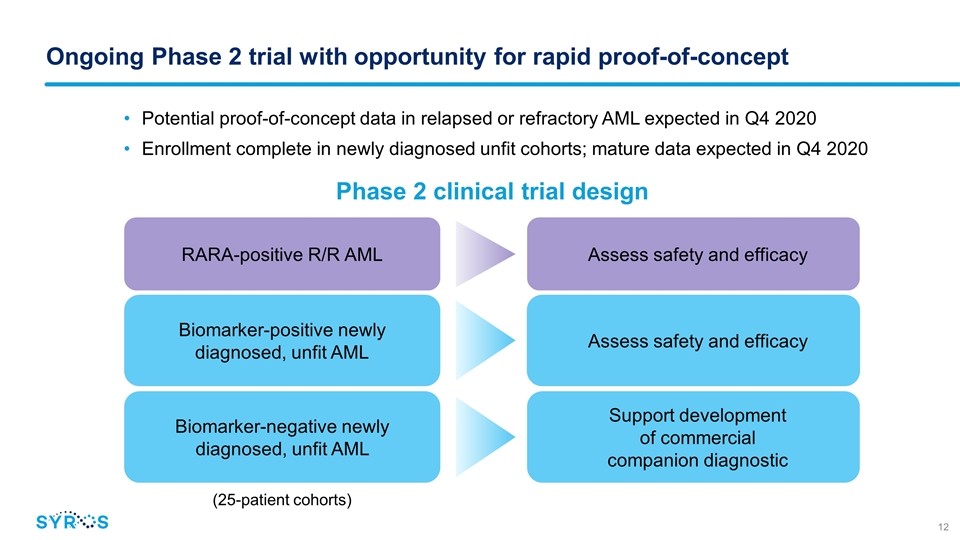
Ongoing Phase 2 trial with opportunity for rapid proof-of-concept Potential proof-of-concept data in relapsed or refractory AML expected in Q4 2020 Enrollment complete in newly diagnosed unfit cohorts; mature data expected in Q4 2020 Phase 2 clinical trial design (25-patient cohorts) Biomarker-positive newly diagnosed, unfit AML Assess safety and efficacy Biomarker-negative newly diagnosed, unfit AML Support development of commercial companion diagnostic RARA-positive R/R AML Assess safety and efficacy
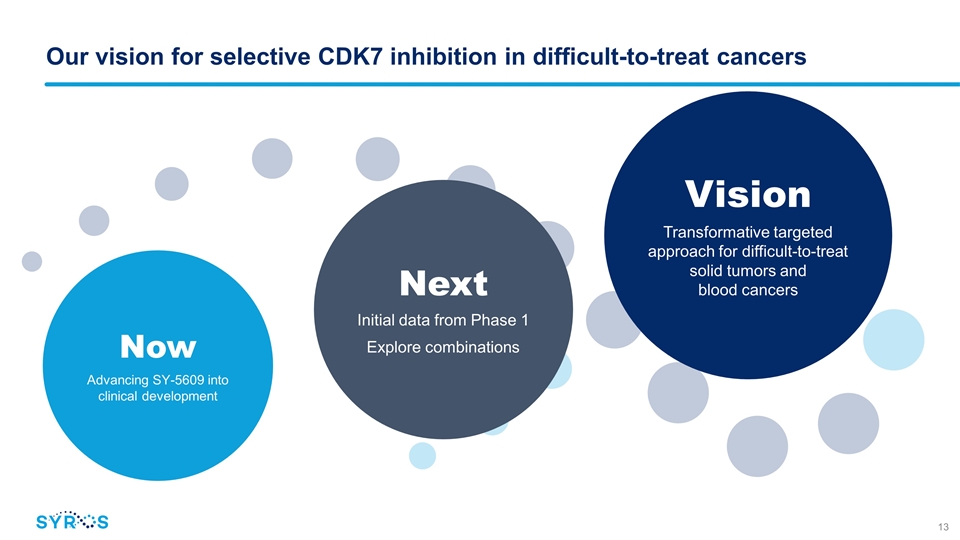
Our vision for selective CDK7 inhibition in difficult-to-treat cancers Now Advancing SY-5609 into clinical development Next Initial data from Phase 1 Explore combinations Vision Transformative targeted approach for difficult-to-treat solid tumors and blood cancers
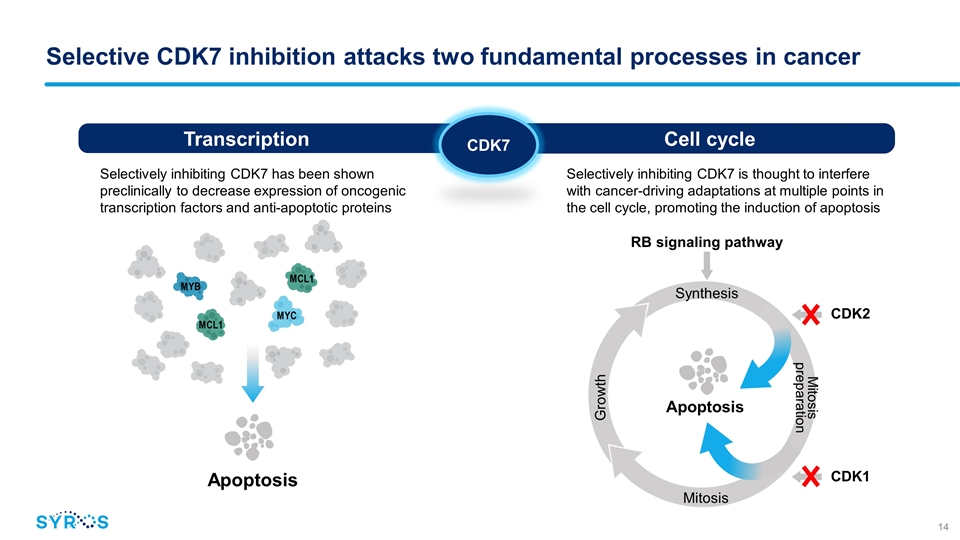
Selective CDK7 inhibition attacks two fundamental processes in cancer Apoptosis Selectively inhibiting CDK7 has been shown preclinically to decrease expression of oncogenic transcription factors and anti-apoptotic proteins Selectively inhibiting CDK7 is thought to interfere with cancer-driving adaptations at multiple points in the cell cycle, promoting the induction of apoptosis MYC MYB MCL1 MCL1 Cell cycle Transcription CDK7 Apoptosis RB signaling pathway Synthesis Growth Mitosis preparation Mitosis CDK2 CDK1

SY-5609: A highly selective oral CDK7 inhibitor with best-in-class potential 0.06 nM potency for CDK7 13,000- to 49,000-fold more selective for CDK7 over CDK2, CDK9 and CDK12 Only 4 of 485 kinases inhibited at ≥ 90% 100-91% Inhibition 90-80% Inhibition 79-71% Inhibition Data presented in October 2019 at EORTC-NCI-AACR Conference Induced apoptosis in cancer cells but not in non-cancer cells DMSO SY-5609 100nM SY-5609 250nM SY-5609 500nM Non-cancer cells Cancer cells %Annexin V/PI + 60 50 40 30 20 10 0
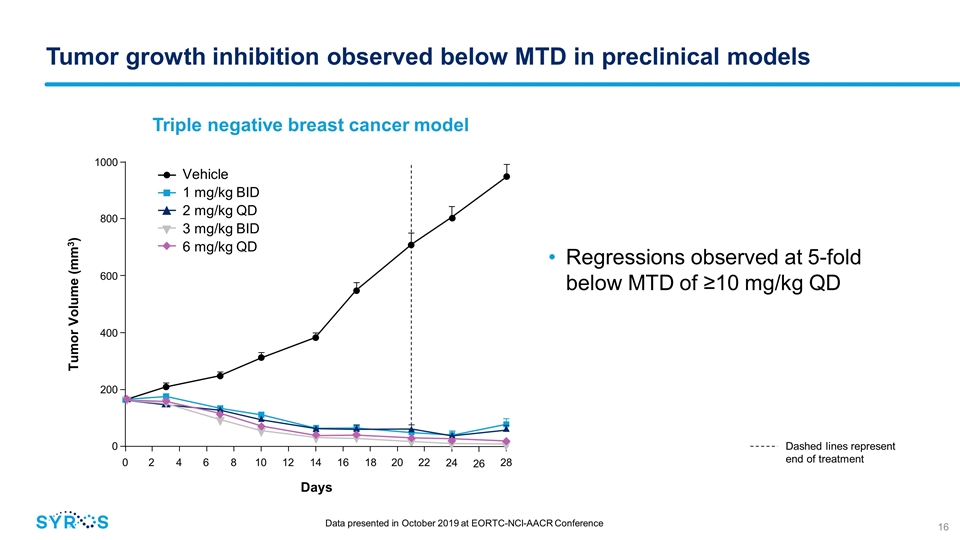
Tumor growth inhibition observed below MTD in preclinical models Regressions observed at 5-fold below MTD of ≥10 mg/kg QD Triple negative breast cancer model Dashed lines represent end of treatment Data presented in October 2019 at EORTC-NCI-AACR Conference Vehicle 1 mg/kg BID 2 mg/kg QD 3 mg/kg BID 6 mg/kg QD 0 2 4 6 8 10 12 14 16 18 20 22 Days 24 26 28 0 200 400 600 800 1000 Tumor Volume (mm3)
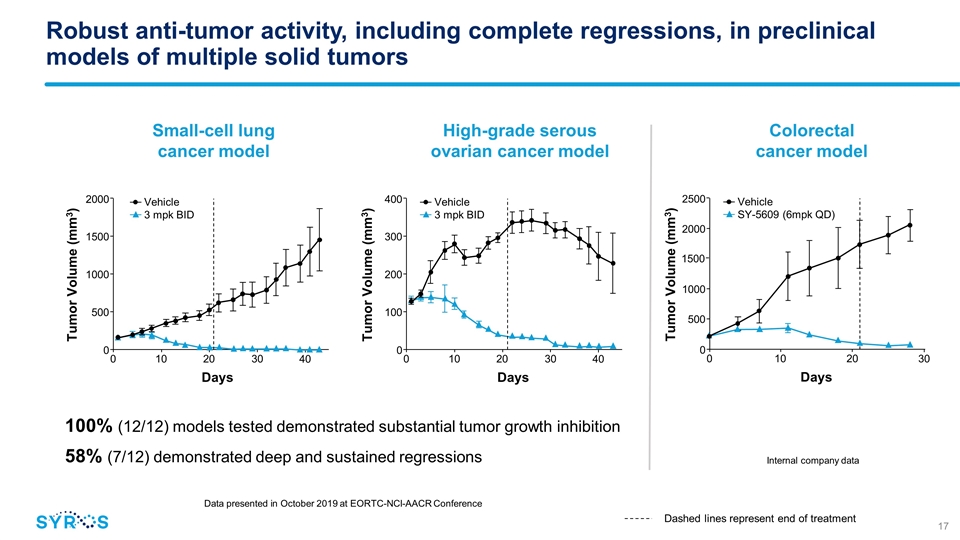
Days 0 10 20 30 40 0 100 200 300 400 Tumor Volume (mm3) 0 10 20 30 Days 40 0 500 1000 1500 2000 Tumor Volume (mm3) High-grade serous ovarian cancer model Small-cell lung cancer model Robust anti-tumor activity, including complete regressions, in preclinical models of multiple solid tumors Colorectal cancer model 100% (12/12) models tested demonstrated substantial tumor growth inhibition 58% (7/12) demonstrated deep and sustained regressions Vehicle 3 mpk BID Vehicle 3 mpk BID Dashed lines represent end of treatment Data presented in October 2019 at EORTC-NCI-AACR Conference Internal company data Days 0 10 20 30 0 500 1000 2000 2500 Tumor Volume (mm3) Vehicle SY-5609 (6mpk QD) 1500
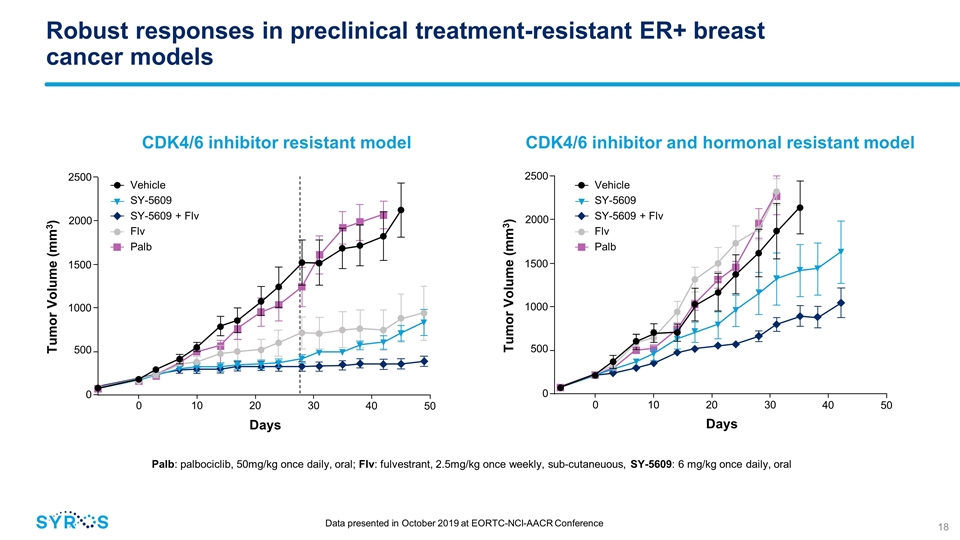
Robust responses in preclinical treatment-resistant ER+ breast cancer models Palb: palbociclib, 50mg/kg once daily, oral; Flv: fulvestrant, 2.5mg/kg once weekly, sub-cutaneuous, SY-5609: 6 mg/kg once daily, oral Data presented in October 2019 at EORTC-NCI-AACR Conference CDK4/6 inhibitor resistant model CDK4/6 inhibitor and hormonal resistant model 0 10 20 30 Days 40 0 500 1000 1500 2500 Tumor Volume (mm3) 2000 50 Vehicle SY-5609 SY-5609 + Flv Flv Palb Vehicle SY-5609 SY-5609 + Flv Flv Palb 0 10 20 30 Days 40 0 500 1000 1500 2500 Tumor Volume (mm3) 2000 50
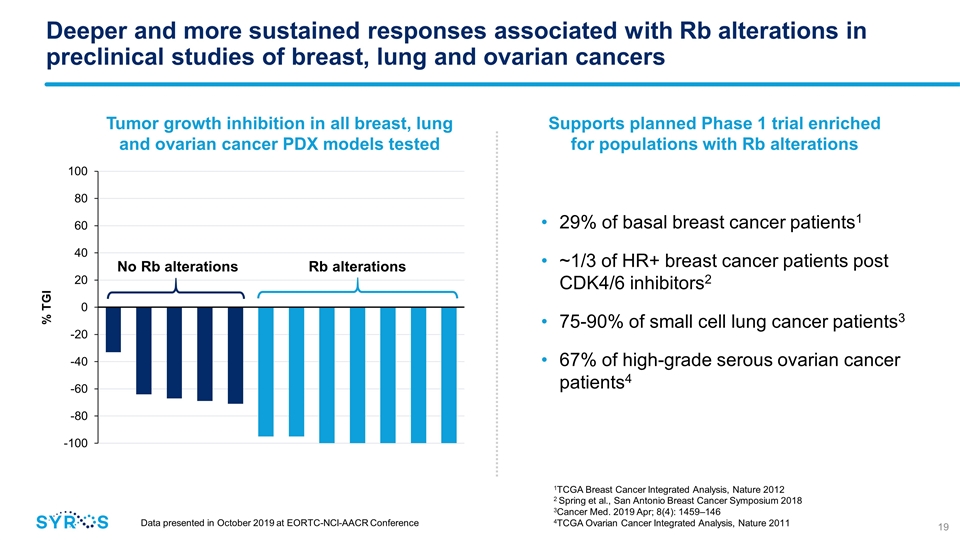
Deeper and more sustained responses associated with Rb alterations in preclinical studies of breast, lung and ovarian cancers Data presented in October 2019 at EORTC-NCI-AACR Conference 29% of basal breast cancer patients1 ~1/3 of HR+ breast cancer patients post CDK4/6 inhibitors2 75-90% of small cell lung cancer patients3 67% of high-grade serous ovarian cancer patients4 Supports planned Phase 1 trial enriched for populations with Rb alterations 1TCGA Breast Cancer Integrated Analysis, Nature 2012 2 Spring et al., San Antonio Breast Cancer Symposium 2018 3Cancer Med. 2019 Apr; 8(4): 1459–146 4TCGA Ovarian Cancer Integrated Analysis, Nature 2011 No Rb alterations Rb alterations % TGI Tumor growth inhibition in all breast, lung and ovarian cancer PDX models tested
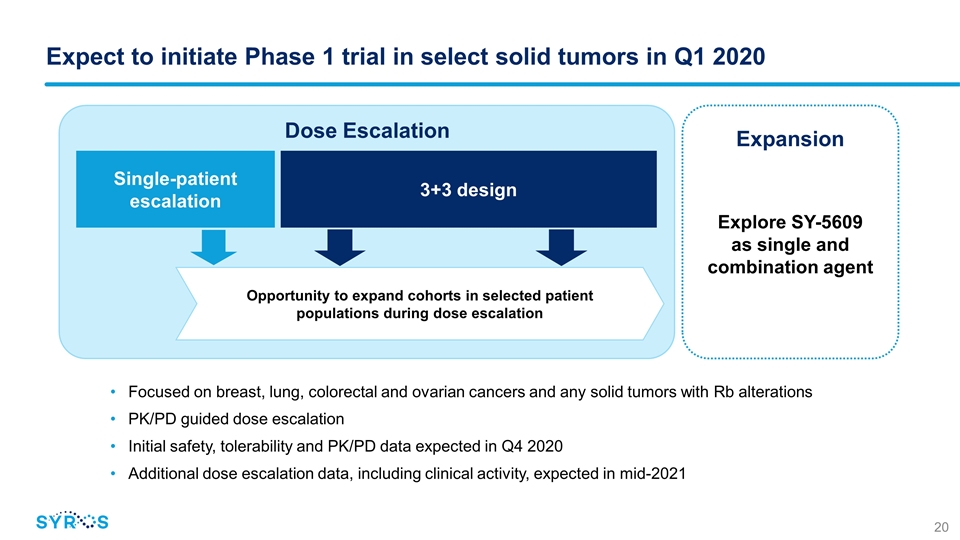
Expect to initiate Phase 1 trial in select solid tumors in Q1 2020 Focused on breast, lung, colorectal and ovarian cancers and any solid tumors with Rb alterations PK/PD guided dose escalation Initial safety, tolerability and PK/PD data expected in Q4 2020 Additional dose escalation data, including clinical activity, expected in mid-2021 Single-patient escalation 3+3 design Opportunity to expand cohorts in selected patient populations during dose escalation Dose Escalation Expansion Explore SY-5609 as single and combination agent
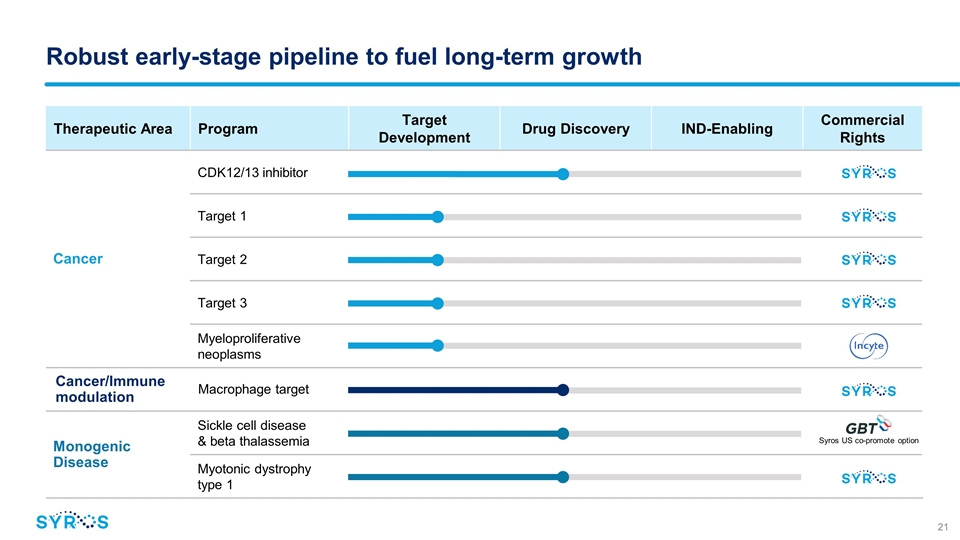
Therapeutic Area Program Target Development Drug Discovery IND-Enabling Commercial Rights Cancer CDK12/13 inhibitor Target 1 Target 2 Target 3 Myeloproliferative neoplasms Cancer/Immune modulation Macrophage target Monogenic Disease Sickle cell disease & beta thalassemia Myotonic dystrophy type 1 Robust early-stage pipeline to fuel long-term growth Syros US co-promote option
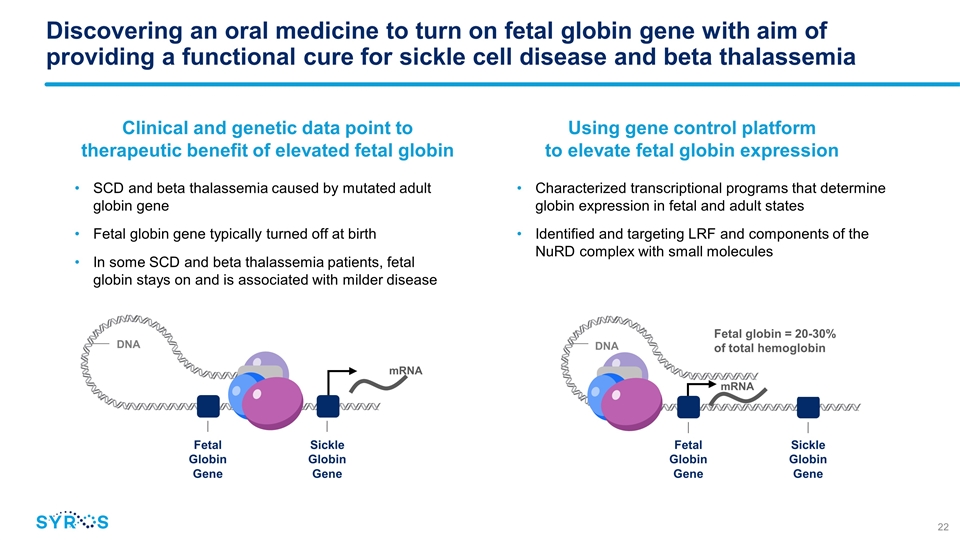
Discovering an oral medicine to turn on fetal globin gene with aim of providing a functional cure for sickle cell disease and beta thalassemia SCD and beta thalassemia caused by mutated adult globin gene Fetal globin gene typically turned off at birth In some SCD and beta thalassemia patients, fetal globin stays on and is associated with milder disease Clinical and genetic data point to therapeutic benefit of elevated fetal globin Using gene control platform to elevate fetal globin expression mRNA Sickle Globin Gene DNA mRNA Fetal Globin Gene Sickle Globin Gene DNA Fetal Globin Gene Characterized transcriptional programs that determine globin expression in fetal and adult states Identified and targeting LRF and components of the NuRD complex with small molecules Fetal globin = 20-30% of total hemoglobin
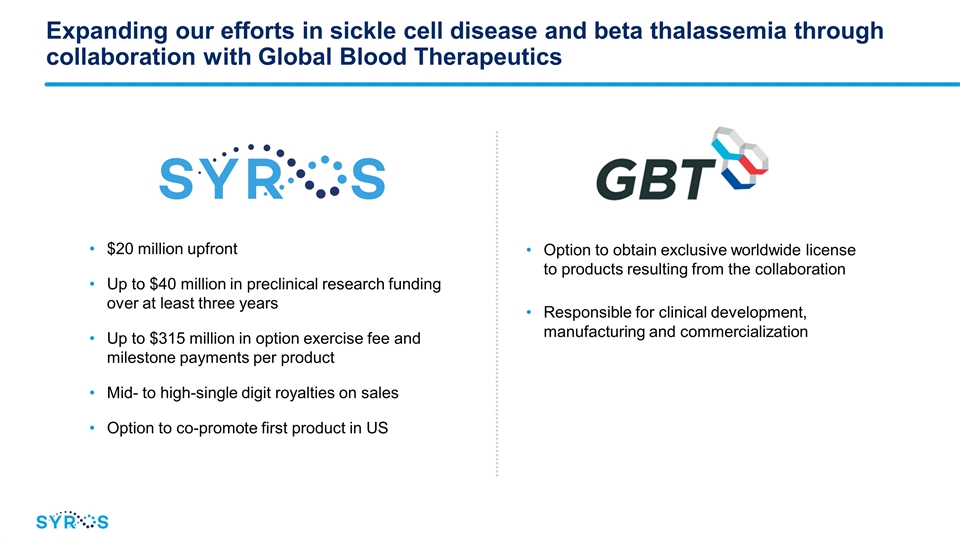
Expanding our efforts in sickle cell disease and beta thalassemia through collaboration with Global Blood Therapeutics Option to obtain exclusive worldwide license to products resulting from the collaboration Responsible for clinical development, manufacturing and commercialization $20 million upfront Up to $40 million in preclinical research funding over at least three years Up to $315 million in option exercise fee and milestone payments per product Mid- to high-single digit royalties on sales Option to co-promote first product in US
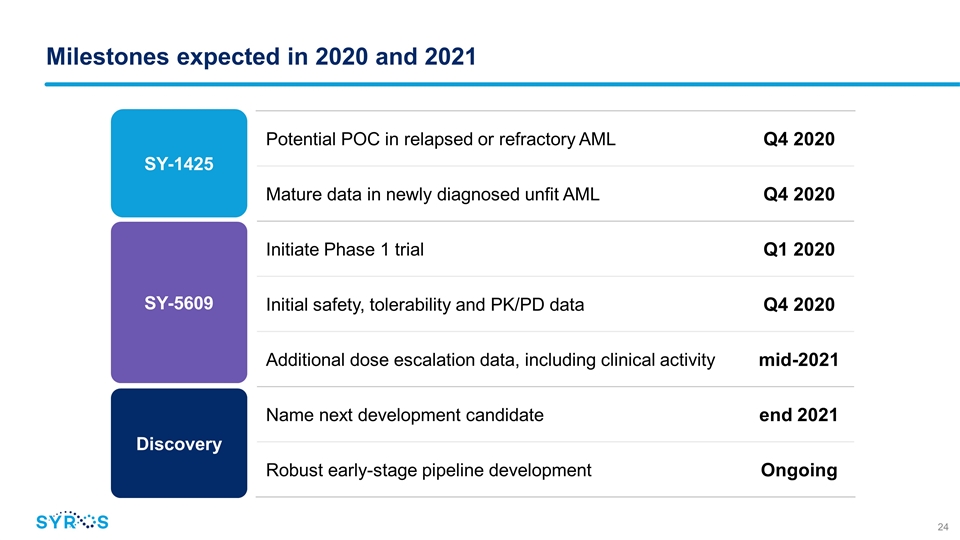
Milestones expected in 2020 and 2021 SY-1425 SY-5609 Discovery Potential POC in relapsed or refractory AML Q4 2020 Mature data in newly diagnosed unfit AML Q4 2020 Initiate Phase 1 trial Q1 2020 Initial safety, tolerability and PK/PD data Q4 2020 Additional dose escalation data, including clinical activity mid-2021 Name next development candidate end 2021 Robust early-stage pipeline development Ongoing
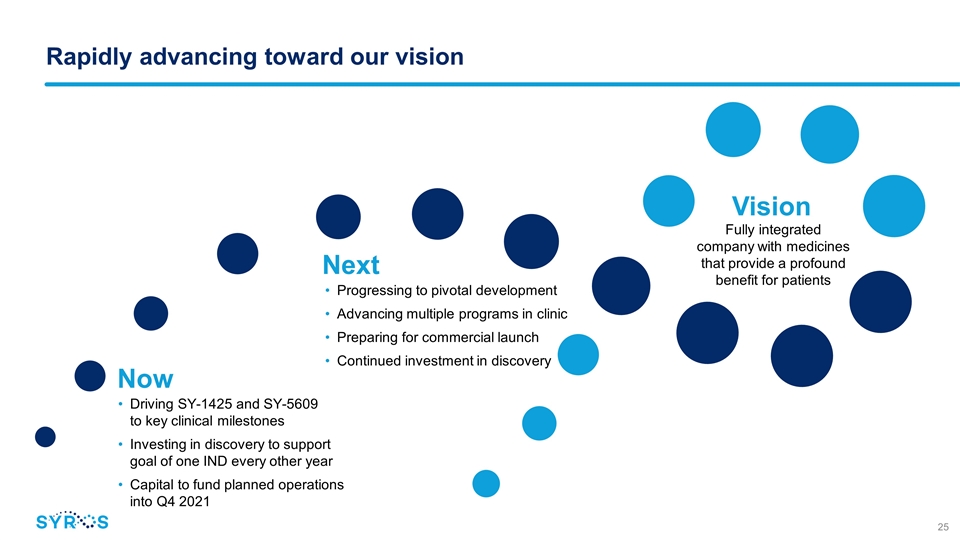
Rapidly advancing toward our vision Progressing to pivotal development Advancing multiple programs in clinic Preparing for commercial launch Continued investment in discovery Fully integrated company with medicines that provide a profound benefit for patients Driving SY-1425 and SY-5609 to key clinical milestones Investing in discovery to support goal of one IND every other year Capital to fund planned operations into Q4 2021 Now Next Vision

Appendix
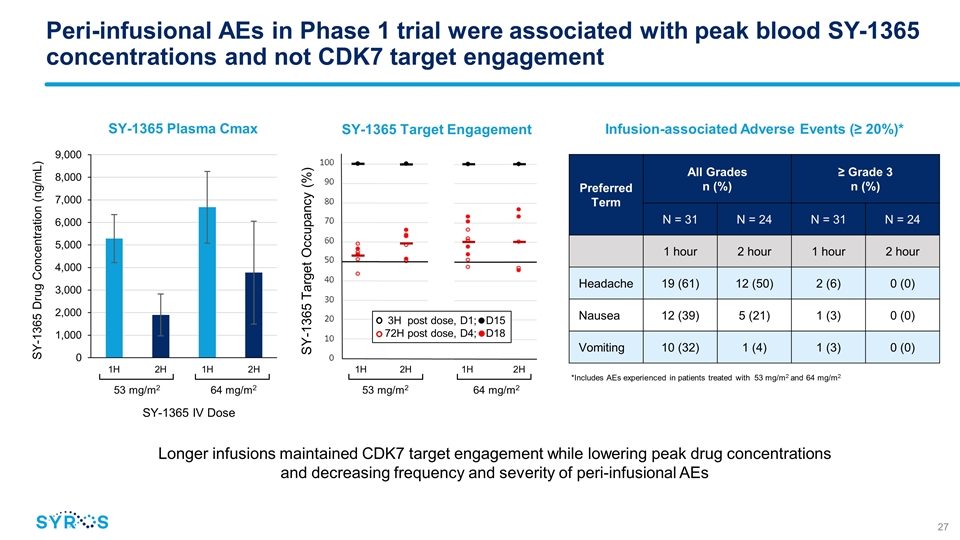
1H2H1H 2H 53 mg/m2 64 mg/m2 Peri-infusional AEs in Phase 1 trial were associated with peak blood SY-1365 concentrations and not CDK7 target engagement Longer infusions maintained CDK7 target engagement while lowering peak drug concentrations and decreasing frequency and severity of peri-infusional AEs 1H2H1H2H 53 mg/m2 64 mg/m2 SY-1365 Target Engagement Preferred Term All Grades n (%) ≥ Grade 3 n (%) N = 31 N = 24 N = 31 N = 24 1 hour 2 hour 1 hour 2 hour Headache 19 (61) 12 (50) 2 (6) 0 (0) Nausea 12 (39) 5 (21) 1 (3) 0 (0) Vomiting 10 (32) 1 (4) 1 (3) 0 (0) Infusion-associated Adverse Events (≥ 20%)* *Includes AEs experienced in patients treated with 53 mg/m2 and 64 mg/m2 SY-1365 IV Dose 3H post dose, D1; D15 72H post dose, D4; D18 SY-1365 Target Occupancy (%)
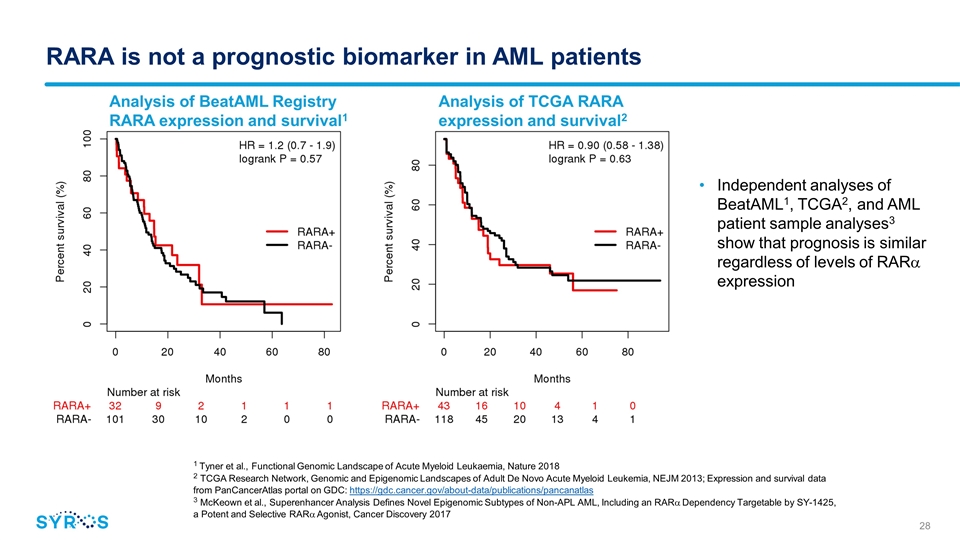
RARA is not a prognostic biomarker in AML patients Analysis of BeatAML Registry RARA expression and survival1 1 Tyner et al., Functional Genomic Landscape of Acute Myeloid Leukaemia, Nature 2018 2 TCGA Research Network, Genomic and Epigenomic Landscapes of Adult De Novo Acute Myeloid Leukemia, NEJM 2013; Expression and survival data from PanCancerAtlas portal on GDC: https://gdc.cancer.gov/about-data/publications/pancanatlas 3 McKeown et al., Superenhancer Analysis Defines Novel Epigenomic Subtypes of Non-APL AML, Including an RARa Dependency Targetable by SY-1425, a Potent and Selective RARa Agonist, Cancer Discovery 2017 Analysis of TCGA RARA expression and survival2 Independent analyses of BeatAML1, TCGA2, and AML patient sample analyses3 show that prognosis is similar regardless of levels of RARa expression
